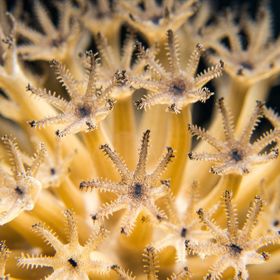

brettforsyth
Follow
For more photos and info go to http:--www.brettforsyth.com
For more photos and info go to http:--www.brettforsyth.com
Read less
Read less
Views
1175
Likes
Awards
Featured
Contest Finalist in Underwater Imagination Photo Contest
Peer Award
Top Choice
Superb Composition
Absolute Masterpiece
Outstanding Creativity
All Star
Genius
Superior Skill
Magnificent Capture
Top Ranks
Categories
Same photographer See allBehind The Lens
Discover more photos See all
Behind The Lens
Location
Turneffe Atoll, Belize. More specifically on a dive site called Crickozeen. Located on the central westside of the atoll this site has a mooring pin in middle of an ~50m wide half moon shaped sand chute. There are coral patches in the middle of the chute that then slopes off into the deep. There is a wall on both sides North Crickozeen/South Crickozeen. The north site starts with a sloping area of corals for about 12m (barrel, vase, tube sponges, fern, brain, flower, fire corals), that transitions into a sloping wall and then a vertical wall. This runs for about 75m dropping to a depth of 40m, from there the wall slopes off to the north for about 100m where you will encounter a sandy slope rich with marine life and corals. To the south there is a sloping scattered coral formation that runs for 12m into a narrow sand chute. It then becomes a sloping elbow shaped wall that runs for 120m into another sand chute. At the tip of the elbow there is a ledge at 15m and a wall that goes vertically down to 45m.Time
It was 3:30pm CT. Warm, sunny and calm water perfect dive conditions.Lighting
Flash is pretty critical for underwater photography and especially macro. A single Sea&Sea YS-01 strobe was used set to manual. Flash position was always on my mind as it controls how much backscatter you get in your images. Backscatter, in the underwater photography, is when your flash illuminates the particles in the water making them very bright.Equipment
Sony RX100II with a Nauticam housing, Sea&Sea YS-01 Strobe, 2x 5" Ultralight, Ultralight tray and handle, Nauticam M67 Flip Diopter Holder and 2x Bluewater +7 Macro LensInspiration
I was inspired to take photos of everything on this trip. I find diving to be almost overwhelming in terms of interesting subjects. These corals in particular seems almost soft and fuzzy from a distance but as you approached the detail of the polyps resolves. Here is a colony of animals swaying gently in the current feeding away.Editing
I use lightroom so these are specific to that program: +10 clarity& vibrance, set appropriate black and white values, and some contrast. Minor backscatter removal. I try to not crush my black to much and to keep colors punchy but not nuked.In my camera bag
For underwater I have all the equipment listed above plus a INON UCL-330Feedback
Get to know your equipment before you ever hit the water. I had read a ton before the camera touched the water which allowed me to pre-program common settings into the sony (macro, wide and video). This made changing modes much easier. A single strobe can be just as good as dual strobes but you really have to work the position. Learning how to use a strobes manual controls gives you much more control of your exposure.










































